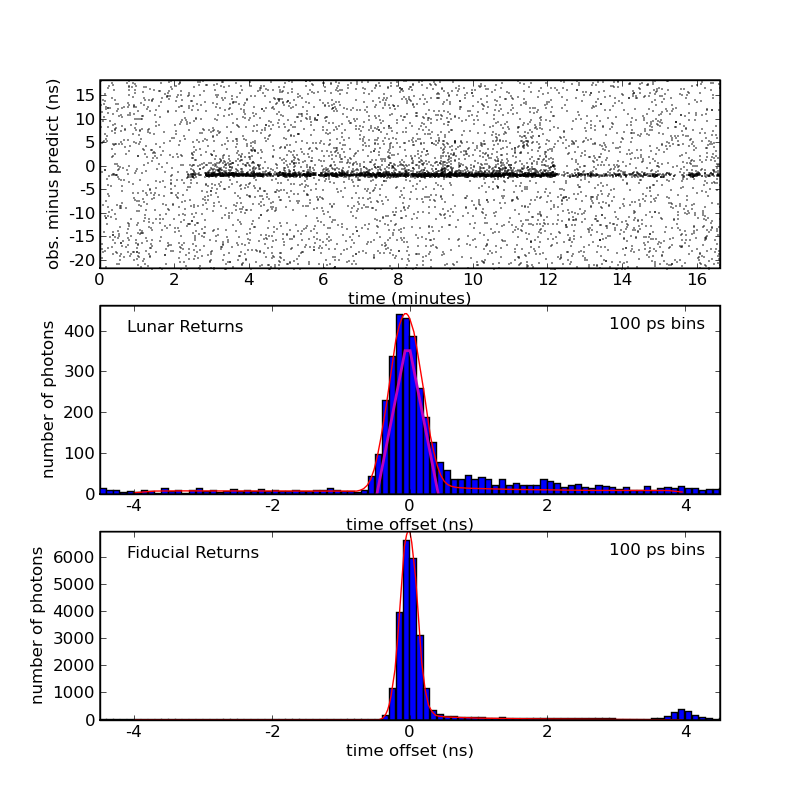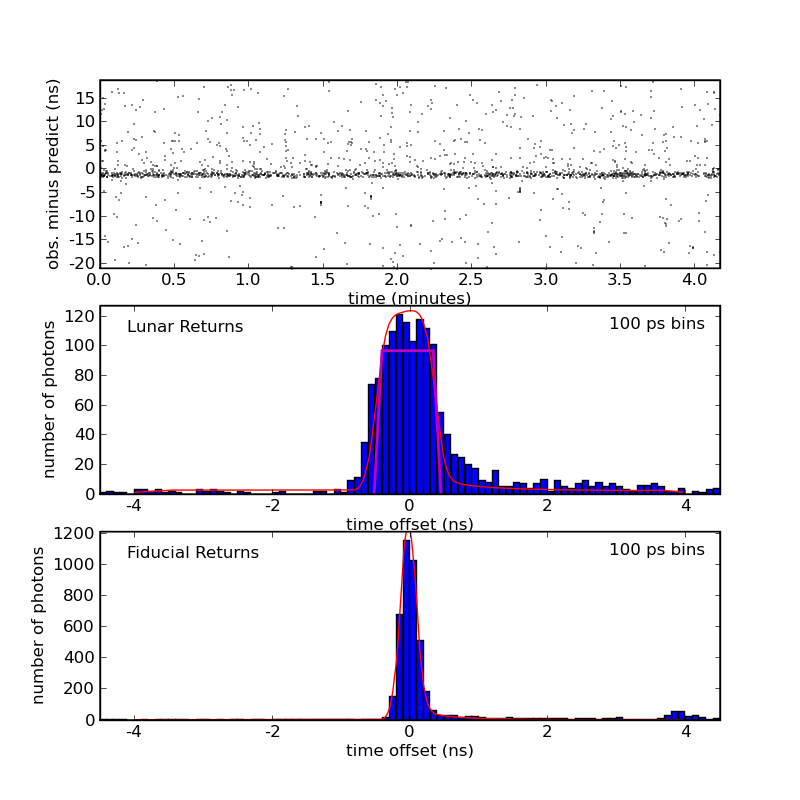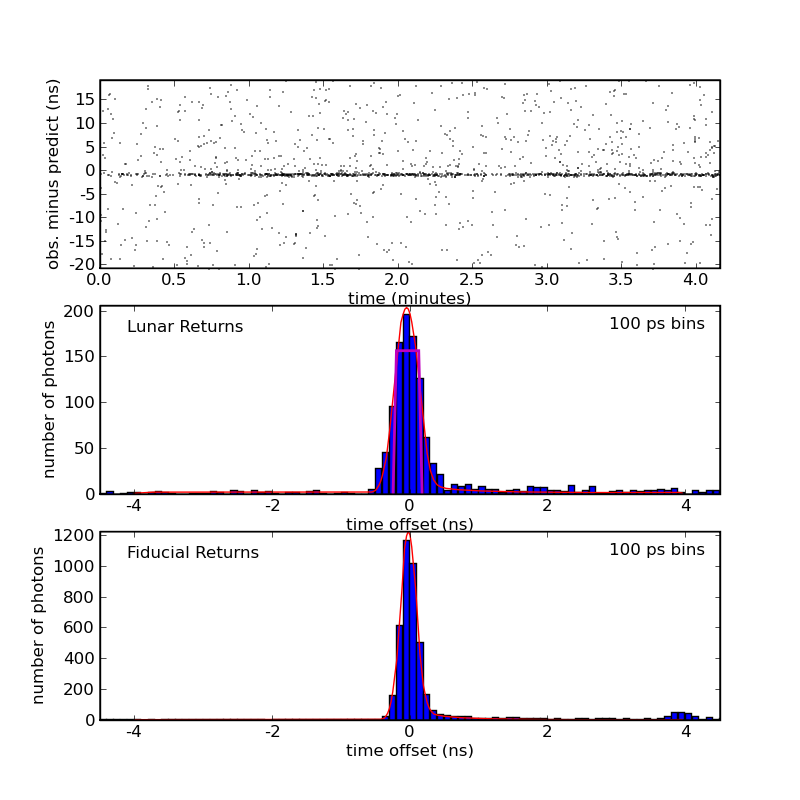APOLLO telescope time is scheduled in short (1 hour or less) blocks throughout the month for optimal sampling of the lunar orbit.
APOLLO started getting "sky time" in July 2005—a combination of engineering time and director's discretionary time. Snippets of time in July, August, and September of 2005 allowed us to hone our technique and develop the software resources we needed to be successful on our first "real" run in October, when we first installed the signal-boosting microlens array. The first science-quality runs started in April 2006, and the regular cadence of < 1 hour blocks throughout the month began in October 2006. See the story of our first year for more about progress during our ramp-up period. A month-by-month summary of yield is also available.
In September 2007, we started seeing much higher return rates than we saw previously. Overall, as of April 2008, our median APOLLO normal point has an estimated error of 3.3 mm. In the period since September 2007, this is down to 2.4 mm. If we characterize the net uncertainty per reflector per night (we often have more than one normal point per reflector on a given night), the overall median is 1.8 mm, while the recent figure is 1.1 mm.
Our best sessions, all less than one hour in duration, delivered the following photon yields (Lunokhod 1 was not found until 2010-04-23):
| Date | Apollo 11 | Apollo 14 | Apollo 15 | Lunokhod 1 | Lunokhod 2 | Total |
| 2008 Oct 17 | 10868 | 17107 | 38330 | — | 0 | 66305 |
| 2011 Nov 17 | 11951 | 9000 | 15889 | 4280 | 3017 | 44138 |
| 2008 Sep 18 | 3219 | 3460 | 26800 | — | 0 | 33479 |
| 2008 Sep 22 | 5168 | 9330 | 14018 | — | 750 | 29266 |
| 2008 Oct 18 | 1021 | 1698 | 23609 | — | 0 | 26328 |
| 2007 Nov 20 | 4291 | 7177 | 11999 | — | 0 | 23467 |
| 2007 Nov 19 | 3750 | 4001 | 12323 | — | 0 | 20074 |
| 2008 Feb 18 | 1371 | 2414 | 13111 | — | 0 | 16896 |
| 2007 Dec 21 | 1375 | 1987 | 12129 | — | 0 | 15491 |
| 2007 Oct 29 | 1763 | 566 | 8996 | — | 0 | 11525 |
| 2008 Feb 11 | 1143 | 1427 | 8039 | — | 310 | 10919 |
The maximum sustained rate (for at least 2000 shots, or 100 seconds) for each of the reflectors is as follows:
| Reflector | Date | Laser Shots | # photons | photons/minute | photons/shot |
| Apollo 11 | 2011-11-17 | 2000 | 3708 | 2225 | 1.85 |
| Apollo 14 | 2008-10-17 | 5000 | 7606 | 1825 | 1.52 |
| Apollo 15 | 2008-10-17 | 5000 | 15730 | 3775 | 3.15 |
| Lunokhod 1 | 2011-11-17 | 2000 | 1276 | 765 | 0.64 |
| Lunokhod 2 | 2011-11-17 | 2000 | 713 | 428 | 0.36 |
The highest-yield run for each of the reflectors is as follows:
| Reflector | Date | Laser Shots | # photons | photons/minute | photons/shot |
| Apollo 11 | 2011-11-17 | 5000 | 4784 | 1148 | 0.96 |
| Apollo 14 | 2008-10-17 | 5000 | 7606 | 1825 | 1.52 |
| Apollo 15 | 2008-10-17 | 5000 | 15730 | 3775 | 3.15 |
| Lunokhod 1 | 2011-11-17 | 5000 | 2070 | 497 | 0.41 |
| Lunokhod 2 | 2011-11-17 | 5000 | 1301 | 312 | 0.26 |
In addition, APOLLO has seen a number of pulses with as many as ten returning photons in a pulse. This is a lower limit, as our APD detector is saturated in this high-signal regime.
Below are example strong runs. The first two are Apollo 15 at two different libration states, resulting in different reflector orientations and thus different temporal profiles (magenta "theory" line). The last plot is Apollo 11 on the same night as the second Apollo 15 example, which shows dramatically the difference in physical size of each array.
In each plot, the top panel shows a 40 nanosecond window of observed
round trip time minus the predicted range. Background noise and detector
dark current appear as scattered dots, while the lunar return is obvious in
the middle. The middle panel shows a histogram of the linar returns, while
the bottom panel shows the local "fiducial" corner cube return.
The latter characterizes the APOLLO system response (laser pulse width,
detector spread, timing electronics jitter). The Lunar return is
additionally spread by the tilted reflector array—modeled by the
superimposed magenta trapezoidal shape. A functional fit to the fiducial
return is convolved with the trapezoid to yield an expected shape of the
lunar return, producing an approximately adequate result (fits are red
curves). The asymmetric tail on both returns is due to diffusion of
photo-electrons from deeply-penetrating photons in the APD detector.


